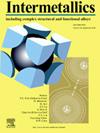Effect of Ti and Mo content changes on microstructure and properties of laser cladding FeCoCrNiMn high entropy alloy coatings
IF 4.3
2区 材料科学
Q2 CHEMISTRY, PHYSICAL
引用次数: 0
Abstract
The HEA coatings of FeCoCrNiMnTixMo1.5-x(x = 0.25, 0.5, 0.75, 1 and 1.25) were prepared by laser cladding. X-ray diffraction (XRD), electron backscatter diffraction (EBSD), and scanning electron microscopy (SEM) were used to characterize the phase and crystal structure. The mechanical properties were tested. The results show that Ti is solidly dissolved in the FCC phase for solid solution strengthening. Mo is precipitated as the second phase σ phase for second phase dispersion strengthening. As x increases, the coating becomes the FCC+σ phase, and the σ phase disappears at x = 1.25. The microhardness and wear resistance of the coating are greatly improved by solution strengthening and second phase precipitation strengthening. The microhardness is up to 3.18 times of the substrate, and the wear resistance is up to 10.9 times of the substrate. Corrosion resistance of all coatings is better than that of 45# steel. With the increase of x, the corrosion resistance of the coating increases first and then decreases. When x = 1, the corrosion resistance of the coating is the best.
钛和钼含量变化对激光熔覆铁钴铬镍锰高熵合金镀层微观结构和性能的影响
通过激光熔覆制备了铁钴铬镍锰铁合金 1.5-x(x = 0.25、0.5、0.75、1 和 1.25)的 HEA 涂层。利用 X 射线衍射 (XRD)、电子反向散射衍射 (EBSD) 和扫描电子显微镜 (SEM) 表征了相和晶体结构。同时还测试了其机械性能。结果表明,钛固溶在 FCC 相中,用于固溶强化。钼作为第二相σ相析出,用于第二相分散强化。随着 x 的增加,涂层变成了 FCC+σ 相,σ 相在 x = 1.25 时消失。通过溶液强化和第二相沉淀强化,涂层的显微硬度和耐磨性大大提高。涂层的显微硬度是基体的 3.18 倍,耐磨性是基体的 10.9 倍。所有涂层的耐腐蚀性均优于 45#钢。随着 x 的增大,涂层的耐腐蚀性先增大后减小。当 x = 1 时,涂层的耐腐蚀性最好。
本文章由计算机程序翻译,如有差异,请以英文原文为准。
求助全文
约1分钟内获得全文
求助全文
来源期刊

Intermetallics
工程技术-材料科学:综合
CiteScore
7.80
自引率
9.10%
发文量
291
审稿时长
37 days
期刊介绍:
This journal is a platform for publishing innovative research and overviews for advancing our understanding of the structure, property, and functionality of complex metallic alloys, including intermetallics, metallic glasses, and high entropy alloys.
The journal reports the science and engineering of metallic materials in the following aspects:
Theories and experiments which address the relationship between property and structure in all length scales.
Physical modeling and numerical simulations which provide a comprehensive understanding of experimental observations.
Stimulated methodologies to characterize the structure and chemistry of materials that correlate the properties.
Technological applications resulting from the understanding of property-structure relationship in materials.
Novel and cutting-edge results warranting rapid communication.
The journal also publishes special issues on selected topics and overviews by invitation only.
 求助内容:
求助内容: 应助结果提醒方式:
应助结果提醒方式:


